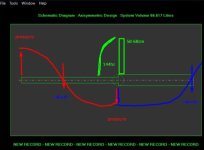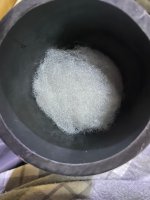Maybe we should study/investigate this ? A stub at the end of the upstream ‘TL’ that’s as long as it’s second resonace? I dunno if it works as well as the offset driver position at 60 cm that would prevent it from even existing?
Attachments
Last edited:
This
View attachment 1376960
does not equal this
View attachment 1376961
The pic below is a more accurate Stepped TH model of the above pic based on the actual tap points.
View attachment 1376963
View attachment 1376966
i
the drivers offset is about 5''/12.7cm in the red section and nearly twice that in the blue section (?)
I don’t know what that would do in such a complicated box but that measured resonace with the red arrow on it is the same 1/4wave length as 1/3 of the blue resonator?
Last edited:
Driver offset ?
25cm is 345.6 hz
15cm is 576 hz…
@David McBean
—> absolutely amazing how Mr. McBean created something that can see these details in math?!?!
Last edited:
Your 2nd red arrow (L23) should end at the speaker mounting board.View attachment 1377047
the drivers offset is about 5''/12.7cm in the red section and nearly twice that in the blue section (?)
All the other red, blue, and green arrows are correct.
I got the sim dialed to the measurement? But Now what part of the ‘roar’ is each resonance from?
Driver offset?
25cm is 345.6 hz
15cm is 576 hz…
@David McBean
—> absolutely amazing how Mr. McBean created something that can see these details in math?!?!
If L12 = 15cm, then L34 = 15cm + thickness of wood + the height of the 90cm2 CSA.
DMB is the man!
Can you Draw it? I’m dumb (as you know😝)Your 2nd red arrow (L23) should end at the speaker mounting board.
All the other red, blue, and green arrows are correct.
I saw that video yesterday or Sunday night. $80 is ALOT for a 2" sub. I wonder how they would perform in an existing sound bar.
Can you Draw it? I’m dumb (as you know😝)
I did in post #339.
Note the lateral green line crossing the vertical red arrow.
Might fit as a suppository to resolve @maxolini constipation issues? We need a volunteer(for science).I saw that video yesterday or Sunday night. $80 is ALOT for a 2" sub. I wonder how they would perform in an existing sound bar.
I am a bit unsure about the last pages, how is this related to the ROAR15 enclosure?
Anyways, back to topic:
I have been trying to setup a cardioid/gradient array with the ROAR15 twice now, but have not been able to get the desired results.
Did not make a difference if I placed them alongside or on top of each other.
I took the mouth of the subwoofer as the point of reference.
The rear subwoofer was reversed, then it was delayed by 82cm/2,39ms and phase inverted and gain was reduced by 4 dB. Since I did not bring a mic, the gain reduction was tuned by ear, and worked better than -0/-2/-6/-8 dB.
It certainly did produce some results, but not quite what I hoped for. Almost perfect cancellation occured at a 45° angle at the rear. Behind the subwoofers, there was notably less sound pressure than in front of the subs. Also, it was more quite when compared to the solo front sub.
Still, in my understanding, cancellation should be strongest behind the subs, not diagonally behind it...?
@weltersys @Circlomanen @martinsson Could this be related to the front resonator?
a little illustration for how i set it up.

picture taken from https://fohonline.com/articles/tech-feature/cardioid-directional-subwoofer-arrays-part-1/
Anyways, back to topic:
I have been trying to setup a cardioid/gradient array with the ROAR15 twice now, but have not been able to get the desired results.
Did not make a difference if I placed them alongside or on top of each other.
I took the mouth of the subwoofer as the point of reference.
The rear subwoofer was reversed, then it was delayed by 82cm/2,39ms and phase inverted and gain was reduced by 4 dB. Since I did not bring a mic, the gain reduction was tuned by ear, and worked better than -0/-2/-6/-8 dB.
It certainly did produce some results, but not quite what I hoped for. Almost perfect cancellation occured at a 45° angle at the rear. Behind the subwoofers, there was notably less sound pressure than in front of the subs. Also, it was more quite when compared to the solo front sub.
Still, in my understanding, cancellation should be strongest behind the subs, not diagonally behind it...?
@weltersys @Circlomanen @martinsson Could this be related to the front resonator?
a little illustration for how i set it up.
picture taken from https://fohonline.com/articles/tech-feature/cardioid-directional-subwoofer-arrays-part-1/
Last edited:
I would guess that the plane wave that exits the front resonator is too directional in it self to properly cancel well in a cardiod setup. You might get better results with a bass reflex box as the cardioid cancelation part.Still, in my understanding, cancellation should be strongest behind the subs, not diagonally behind it...?
I managed to get it to work fairly well with the roar15, but with a delay of 5.6ms and the rear facing sub 4db quieter (I had the bottom one facing backwards and the one above it facing forwards, bit of a waste having the 2nd cardiode sub but it worked aesthetically in terms of the stack design).
I've recently done the same thing with my new dual 15 subs. 6 seconds delay seemed to work best. I kind of did it by ear in the end as I dont entirely trust my measuring (it seems inconsistent). You can tell as the phase changes with various delay settings that the upper bass drops the lower bass comes back, and vice versa. I aimed to try to cut out as much as possible of the lower end (under 60hz). I don't think its possible to do it effectively for both the lower and upper. The low end is what travels more and seems to be the frequencies that one annoying guy with his sound meter complains about.
Another thing that stumped me for a while is the amp I was using to drive the cardiode subs also had low and high pass filters enabled. The filters weren't necessary as I was already going through a PA management system, but they wreaked havoc with the cancelation response. Once I realised this and turned them off things behaved as expected. Make sure you havent done something similar.
Based on my experience I say you need a bit more delay.
I've recently done the same thing with my new dual 15 subs. 6 seconds delay seemed to work best. I kind of did it by ear in the end as I dont entirely trust my measuring (it seems inconsistent). You can tell as the phase changes with various delay settings that the upper bass drops the lower bass comes back, and vice versa. I aimed to try to cut out as much as possible of the lower end (under 60hz). I don't think its possible to do it effectively for both the lower and upper. The low end is what travels more and seems to be the frequencies that one annoying guy with his sound meter complains about.
Another thing that stumped me for a while is the amp I was using to drive the cardiode subs also had low and high pass filters enabled. The filters weren't necessary as I was already going through a PA management system, but they wreaked havoc with the cancelation response. Once I realised this and turned them off things behaved as expected. Make sure you havent done something similar.
Based on my experience I say you need a bit more delay.
Last edited:
The time of flight distance is from the center of the mouth, around the cabinet side, to the center of the rear of the cabinet, a minimum of 164mm, ~4.7ms.I took the mouth of the subwoofer as the point of reference.
The rear subwoofer was reversed, then it was delayed by 82cm/2,39ms and phase inverted and gain was reduced by 4 dB.
In addition, there is a diagonal distance to add in.
At what frequency?Since I did not bring a mic, the gain reduction was tuned by ear, and worked better than -0/-2/-6/-8 dB.
What is the passband of your Roar?
As well as your delay time being off, you have not mentioned distance from boundaries, the reflections from them influence results.It certainly did produce some results, but not quite what I hoped for. Almost perfect cancellation occured at a 45° angle at the rear. Behind the subwoofers, there was notably less sound pressure than in front of the subs. Also, it was more quite when compared to the solo front sub.
Still, in my understanding, cancellation should be strongest behind the subs, not diagonally behind it...?
Also, the ground plane mirrors the outputs, the forward facing sub on the bottom or top will have different rear angular results.
The frequency range above ~60Hz has some directionality from the horn, centering the rear cancellation on the omni-directional lower frequency range is a more effective than centering on the entire passband.
A "plane wave" propagates in only one direction, the output of the cabinet is more directional in the upper range, but none of it's output is a plane wave after exiting the mouth.I would guess that the plane wave that exits the front resonator is too directional in it self to properly cancel well in a cardiod setup.
Art
That would be 6000 milliseconds, sound travels about 2058 meters (1.28 miles) in that time 😉 .6 seconds delay seemed to work best.
Maybe he has his subs placed about 1,28 miles closer to the public than the rest? Then it would be spot-on 😉hat would be 6000 milliseconds, sound tra😉vels about 2058 meters (1.28 miles) in that time 😉 .
- Home
- Loudspeakers
- Subwoofers
- ROAR15


